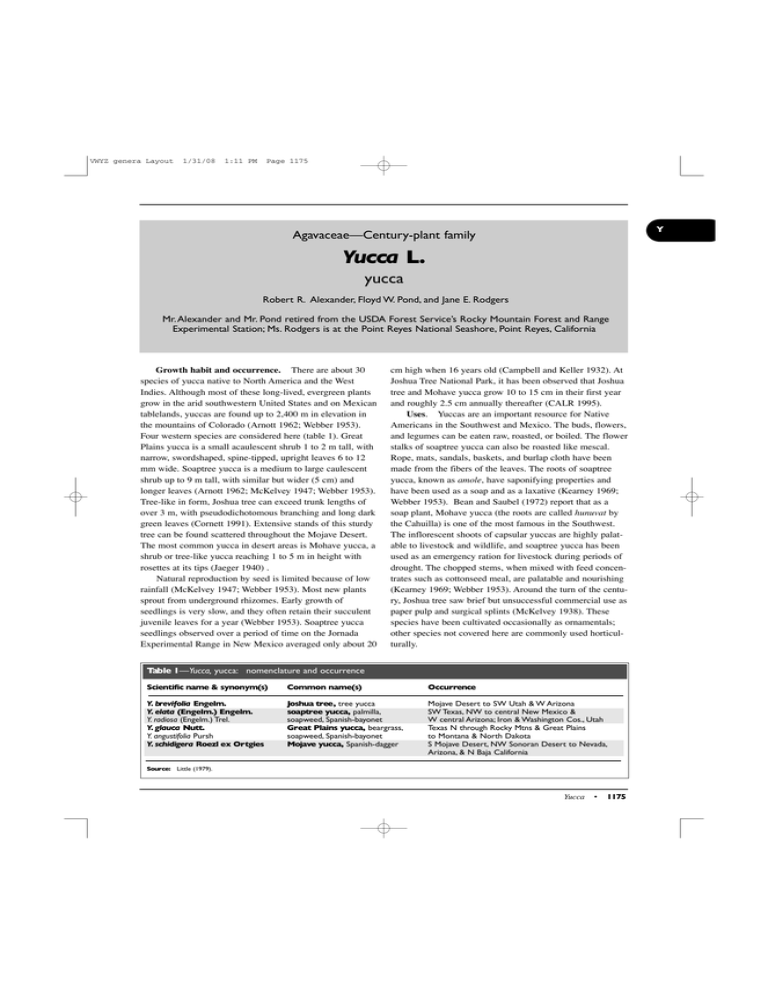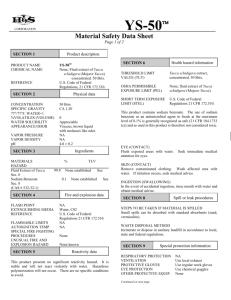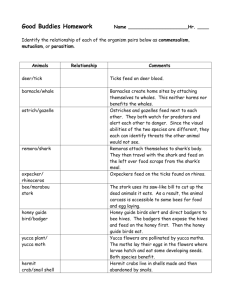Yucca yucca Agavaceae—Century-plant family
advertisement

VWYZ genera Layout 1/31/08 1:11 PM Page 1175 Y Agavaceae—Century-plant family Yucca L. yucca Robert R. Alexander, Floyd W. Pond, and Jane E. Rodgers Mr. Alexander and Mr. Pond retired from the USDA Forest Service’s Rocky Mountain Forest and Range Experimental Station; Ms. Rodgers is at the Point Reyes National Seashore, Point Reyes, California Growth habit and occurrence. There are about 30 species of yucca native to North America and the West Indies. Although most of these long-lived, evergreen plants grow in the arid southwestern United States and on Mexican tablelands, yuccas are found up to 2,400 m in elevation in the mountains of Colorado (Arnott 1962; Webber 1953). Four western species are considered here (table 1). Great Plains yucca is a small acaulescent shrub 1 to 2 m tall, with narrow, swordshaped, spine-tipped, upright leaves 6 to 12 mm wide. Soaptree yucca is a medium to large caulescent shrub up to 9 m tall, with similar but wider (5 cm) and longer leaves (Arnott 1962; McKelvey 1947; Webber 1953). Tree-like in form, Joshua tree can exceed trunk lengths of over 3 m, with pseudodichotomous branching and long dark green leaves (Cornett 1991). Extensive stands of this sturdy tree can be found scattered throughout the Mojave Desert. The most common yucca in desert areas is Mohave yucca, a shrub or tree-like yucca reaching 1 to 5 m in height with rosettes at its tips (Jaeger 1940) . Natural reproduction by seed is limited because of low rainfall (McKelvey 1947; Webber 1953). Most new plants sprout from underground rhizomes. Early growth of seedlings is very slow, and they often retain their succulent juvenile leaves for a year (Webber 1953). Soaptree yucca seedlings observed over a period of time on the Jornada Experimental Range in New Mexico averaged only about 20 cm high when 16 years old (Campbell and Keller 1932). At Joshua Tree National Park, it has been observed that Joshua tree and Mohave yucca grow 10 to 15 cm in their first year and roughly 2.5 cm annually thereafter (CALR 1995). Uses. Yuccas are an important resource for Native Americans in the Southwest and Mexico. The buds, flowers, and legumes can be eaten raw, roasted, or boiled. The flower stalks of soaptree yucca can also be roasted like mescal. Rope, mats, sandals, baskets, and burlap cloth have been made from the fibers of the leaves. The roots of soaptree yucca, known as amole, have saponifying properties and have been used as a soap and as a laxative (Kearney 1969; Webber 1953). Bean and Saubel (1972) report that as a soap plant, Mohave yucca (the roots are called hunuvat by the Cahuilla) is one of the most famous in the Southwest. The inflorescent shoots of capsular yuccas are highly palatable to livestock and wildlife, and soaptree yucca has been used as an emergency ration for livestock during periods of drought. The chopped stems, when mixed with feed concentrates such as cottonseed meal, are palatable and nourishing (Kearney 1969; Webber 1953). Around the turn of the century, Joshua tree saw brief but unsuccessful commercial use as paper pulp and surgical splints (McKelvey 1938). These species have been cultivated occasionally as ornamentals; other species not covered here are commonly used horticulturally. Table 1—Yucca, yucca: nomenclature and occurrence Scientific name & synonym(s) Common name(s) Occurrence Y. brevifolia Engelm. Y. elata (Engelm.) Engelm. Y. radiosa (Engelm.) Trel. Y. glauca Nutt. Y. angustifolia Pursh Y. schidigera Roezl ex Ortgies Joshua tree, tree yucca soaptree yucca, palmilla, soapweed, Spanish-bayonet Great Plains yucca, beargrass, soapweed, Spanish-bayonet Mojave yucca, Spanish-dagger Mojave Desert to SW Utah & W Arizona SW Texas, NW to central New Mexico & W central Arizona; Iron & Washington Cos., Utah Texas N through Rocky Mtns & Great Plains to Montana & North Dakota S Mojave Desert, NW Sonoran Desert to Nevada, Arizona, & N Baja California Source: Little (1979). Yucca • 1175 VWYZ genera Layout Y 1/31/08 1:11 PM Page 1176 Flowering and fruiting. The greenish to creamy white flowers are perfect. They appear on terminal panicles from mid-May to mid-July (table 2). Under favorable environmental conditions, plants begin bearing flowers when about 5 to 6 years old. Soaptree yucca bears about 75 to 200 flowers per stalk, but only about 30% of these produce fruits (Campbell and Keller 1932). The fruit is a dehiscent capsule containing 120 to 150 flat, ovoid, black seeds (Campbell and Keller 1932; Ellis 1913). Capsules ripen from mid-July to late September (table 2). Seeds (figures 1 and 2) are wind disseminated in September and October. Yucca pollination seldom occurs without the aid of females of 2 moth species—the yucca moth, Pronuba yuccasella (Riley), and Prodoxus quinquepunctellus (Chambers). These moths gather the pollen, place it in the stigmatic tube, and lay their eggs. The larvae feed exclusively on the maturing seeds but usually consume only a small (20%) portion (Bailey 1962; Ellis 1913; McKelvey 1947; Webber 1953). Collection of fruits. Because the capsules are dehiscent, fruits should be collected just before or at the time the capsules open. They may be picked by hand or stripped from the plants onto canvas (Alexander and Pond 1974). Extraction and storage of seeds. Seeds are easily extracted from dry capsules by hand if the sample is small (Alexander and Pond 1974). With larger samples, dry capsules should be run through a tumbler, revolving box, or drum with screen sides that permit the seeds to fall out. Chaff and other debris can then be winnowed or screened out. Cleaned seeds average 50,000/kg (22,680/lb) for soaptree and Great Plains yuccas (Arnott 1962) and 9,250/kg (4,200/lb) for Joshua tree and Mohave yucca. Seeds have been satisfactorily stored dry at room temperatures, so although no storage tests have been done, the seeds are obviously orthodox in storage behavior. Pregermination treatments. Pretreatment is apparently not needed for successful germination (Arnott 1962), but there is evidence that yuccas exhibit some degree of hardseededness (Webber 1953). The germination period can be reduced by soaking seeds in water for 24 hours at room temperatures or by mechanically scarifying or removing the hard seedcoat at the hilum end. Germination tests. Germination tests for soaptree and Great Plains yuccas have been run at temperatures between 28 and 32 °C, with soaked seeds placed between the folds of moist cotton. The germinative energy of both species after 4 days varied from 45 to 98% (72 samples), with the majority of the samples tested ranging from 80 to 90% (Webber 1953). Tests have also been run in flats in a greenhouse with untreated seeds. Germination after 20 days was 96% for soaptree yucca and 80% for Great Plains yucca (Arnott 1176 • Woody Plant Seed Manual Figure 1—Yucca, yucca: seeds of Y. elata, soaptree (top); Y. brevifolia, Joshua tree (center); Y. schidigera, Mojave yucca (bottom). 1962). After 5 months, however, only 20% of the Great Plains yucca seeds sown had produced living seedlings, whereas all the soaptree yucca germinants were still alive. Germination tests of Joshua tree seeds found maximum germination at 20 to 25 °C and inhibition at 10 to 15 °C VWYZ genera Layout 1/31/08 1:11 PM Page 1177 Table 2—Yucca, yucca: phenology of flowering and fruiting Y Species Location Flowering Fruit ripening Seed dispersal Y. brevifolia Y. elata Y. glauca Y. schidigera — S Arizona, New Mexico, & Texas E Colorado — Mar 1–Apr 1 May 15–July 15 May 15–June 30 Late Mar–early May July 1–Aug 1 Aug 1–late Sept July–Aug Aug–Sept — Sept–Oct Sept — Sources: Kay and others (1977), Kearney and Peebles (1969), McKelvey (1937),Webber (1953). Figure 2—Yucca elata, soaptree yucca: tion through the embryo of a seed. longitudinal sec- (McCleary and Wagner 1973). Seeds do not require scarification for germination (CALR 1995; Went 1948). Kay and others (1977) found that germination remained around 90% for sealed seeds in 3 environments (room temperature, 4 °C, and –15 °C) even after 35 months in storage. Germination treatments are similar for Mohave yucca (CALR 1995). Nursery practice and seedling care. Most plants in botanical gardens or landscape plantings have been either 2- to 3-year-old wildings transplanted from the field or vegetative propagules. Joshua Tree National Park has successfully transplanted older Mohave yucca and Joshua tree specimens (CALR 1995). A few individuals and private nurseries have raised yucca plants from seeds. Good germination was obtained by soaking seeds in water at room temperature for at least 24 hours before sowing in the spring. Germination usually begins in 1 to 2 weeks but may continue for 2 to 3 years. Seedlings should be mulched the first winter if there is danger of frost. Seedlings should be ready for outplanting the second year (Hester 1933; Webber 1953). Yucca seedlings are foraged upon by mule deer (Odocoileus hemionus), rabbits (Sylvilagus spp.), woodrats (Neotoma spp.), and ground squirrels (Citellus spp.) (Cornett 1991). References Alexander RR, Pond FW. 1974. Yucca, yucca. In: Schopmeyer CS, tech. coord. Seed of woody plants in the United States. Agric. Handbk. 450. Washington, DC: USDA Forest Service: 857–858. Arnott, H. 1962. The seed, germination, and seedlings of Yucca. Pub. Bot. 35(1). Berkeley: University of California Press. 164 p. Bailey LH. 1947. Standard encyclopedia of horticulture. 2nd ed. New York: Macmillan: 3529–3530. Bean LJ, Saubel KS. 1972. Temalpakh (from the earth): Cahuilla Indian knowledge and usage of plants. Morongo Indian Reservation, CA: Malki Museum Press. 225 p. Campbell RS, Keller JG. 1932. Growth and reproduction of Yucca elata. Ecology 13(4): 364–375. CALR [Center for Arid Lands Restoration]. 1995. Data filed 1989–1995. Twentynine Palms, CA: National Park Service, Joshua Tree National Park. Cornett JW. 1991. The Joshua tree. Nat. Sci. Pub. 1-91. Palm Springs, CA: Palm Springs Desert Museum. Ellis MM. 1913. Seed production of Yucca glauca. Botanical Gazette 56: 72–78. Hester W. 1933. Yucca from seed. Flower Grower 20(9): 405. Jaeger EC. 1940. Desert wildflowers. Stanford, CA: Stanford University Press. 322 p. Kay BL, Brown CR, Graves WL. 1977. Joshua tree. Mojave Reveg. Notes. 16. Davis: University of California, Agronomy and Range Science. Kearney,TH, Peebles RH. 1969. Arizona flora. 2nd ed. Berkeley: University of California Press: 185–188. Little EL Jr. 1979. Checklist of United States trees (native and naturalized). Agric. Handbk. 541. Washington, DC: USDA Forest Service. 375 p. McKelvey SD. 1937. Yuccas of the southwestern United States: Part 1. Jamaica Plains, MA: Arnold Arboretum of Harvard University. 150 p. McKelvey SD. 1947. Yuccas of the southwestern United States: Part 2. Jamaica Plains, MA: Arnold Arboretum of Harvard University. 192 p. McKleary JA, Wagner KA. 1973. Comparative germination and early growth studies of six species of the genus Yucca. American Midland Naturalist 90: 503–508. Webber JM. 1953. Yuccas of the Southwest. Agric. Monogr. 17. Washington, DC: USDA Forest Service. 97 p. Went FW. 1948. Ecology of desert plants: 2.The effect of rain and temperature on germination and growth. Ecology 30: 1–13. Yucca • 1177







